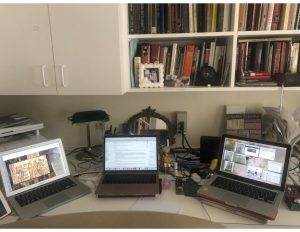Faculty Spotlights - Susan Weiss

“We could cater to [the students] individual schedules in ways not possible before the move to remote teaching.”
Susan Weiss, Associate Professor, Musicology, Modern Languages and Literature
What are some of your main goals as an instructor related to student learning?
First and foremost, as someone with decades of teaching, include 30 years at Peabody, my aim is to have students search for answers as to music’s importance and its role in culture. Our study focuses on composers, styles, sounds, materials and processes associated with how musicians, mostly in the west—but also in other parts of the world— in the early modern era, engaged with their subject as teachers, theorists, learners, singers, instrumentalists, printers, and spectators. As they apply the knowledge accumulated in class, it is hoped that the students continue to thirst for learning about music before the time of J.S. Bach, and come away with how music relates to and remains relevant in today’s society.

How did your teaching progress after you started teaching remotely?
Without painting too rosy a picture, we (my intrepid TA, Rachel O’Connor and I) were able to almost seamlessly move from in-class teaching to remote learning. Sure, there were issues, among them, confusion and concern about the pandemic writ large, families struggling economically, with health problems and worries, zooming in from different time zones, just to name a few. That said, we tried to make the transition as easy as possible, keeping up with the syllabus with remarkably few changes, continuing to present lectures that were also available on the Learning Management System, and devising ways of substituting projects that could be more easily accomplished from the safety of their spaces. We were even able to have a visit from the Peabody Renaissance Ensemble where members demonstrated and performed on their instruments.
What is a challenge you’ve encountered while teaching, and how did you address it?
There were several, some already mentioned, such as students who were located in a time zone 12 hours ahead of our 11 am class time for one class and 5:30 pm in another. It wasn’t easy, but a number managed to stay up late or get up at 5 am to attend class. Other issues involved technology. Not only were local students hampered by low bandwidths, students who went into quarantine once arriving in their home countries were often without internet. Fortunately, the Zoom classes were recorded so that students could view them asynchronously.
I set up office hours and met with students each week. Some students required individual times outside of office hours. Tests were a challenge, but moved to take-home open book format. While I spent more time in front of the computer meeting with students, I felt that many of them were getting increased attention and additional opportunities to ask questions and get help, things that are not always possible in live settings. We could cater to their individual schedules in ways not possible before the move to remote teaching.
 What does your teaching setup at home look like?
What does your teaching setup at home look like?
Most of the time I held class in my home office where I had not one or two, but three laptops and my cell phone available in one place as well as my own library. Occasionally, we met in my music room.
What advice do you have for other faculty?
Spend a little time getting to know the students and have them get to know each other is important. Having had the in-person experience with the students for the first half of the semester helped.
Almost every class involved doing some exercise. Because students (and faculty) were spending inordinate amounts of time in closed quarters sitting at a desk, the need for movement became critical. We often began class with exercise, breathing, stretching and a little cardio. I urged them to take care of their bodies, eating healthy meals and getting enough sleep. Amazingly, we didn’t get behind in the syllabus even with the allowances for time to talk about life. I never thought I would combine teaching musicology with life skills.
How do you want your students to remember this time after they have left Peabody?
Of course, I want them to remember the music, the variety of styles, the struggles of the musicians, the changes in the ways of teaching and learning over a period of thousands of years. In the instruments class, I hope they will not only develop a respect for makers and luthiers, but think about the need for and importance of music in culture. I would like my students in the history and technology of instruments to remember their time working in the maker’s space with Nathan Scott, my co-teacher from engineering and Nonoka, our assistant.
Those precious times could be compared to the adjustments they had to make using DIY materials after the move to remote learning. One very passionate student made a video that shows the dedication and skills needed to accomplish something of which he was be justifiably proud. It’s just one of many.